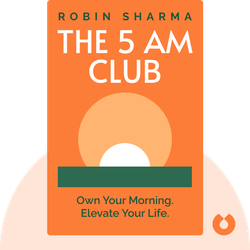Try Blinkist to get the key ideas from 7,000+ bestselling nonfiction titles and podcasts. Listen or read in just 15 minutes.
Start your free trial
Blink 3 of 8 - The 5 AM Club
by Robin Sharma

Taste in An Age of Endless Choice
You May Also Like by Tom Vanderbilt is a fascinating social science book that explores why we like what we like. Vanderbilt uncovers the hidden influences that shape our tastes, from our peers and culture, to our personal history.
Picking a favorite color may seem straightforward, but expressing such a preference is complicated, as it is based on many different factors.
Preferences are both categorical and contextual. While you may treasure your favorite blue sweater, a blue egg would certainly be unappealing. What’s more, even though you wear your blue sweater every weekend, at the office you might prefer to wear only black clothes.
Taste is also constructed. If you’re asked about a favorite color, movie or song, you probably will pick the first good example you can think of and then come up with a reason to justify your preference.
Another factor is that humans are inherently comparative. From childhood onward, it is often the case that we simply like the things that other people like.
And aside from a few exceptions, taste is rarely congenital. The genes we inherit from parents and grandparents don’t inform our individual preferences. When it comes to preferences for certain colors or foods, a better explanation for personal choice is to consider the item’s association with things that are pleasurable.
For instance, many people prefer the color blue, as it evokes peaceful, pleasant things such as a clear, sunny sky or the ocean.
One German study found that adults are influenced by pleasures experienced as an infant. In the study, participants tried two different kinds of tomato ketchup: one natural and one flavored with vanilla. Interestingly, participants who were raised on baby formula preferred the vanilla-flavored ketchup. Researchers connected the dots: as German baby formula contains vanilla flavoring, they discovered that participants had unconsciously associated that flavor with the infant pleasure of being fed.
This kind of association applies to color as well; but like many preferences, it can change over time.
Children instinctively are attracted to yellow-brownish colors, and researchers believe that this could be because these colors remind of a mother’s nipple. But as children grow older, they lose this preference, as other things that are yellow-brown – such as feces or vomit – have unfavorable associations.



You May Also Like (2016) dives into the ever-changing world of taste, or what you like and why you like it. Trying to guess whether a consumer will enjoy a movie or buy a product is both tricky science and big business, as a myriad of different factors influences the decisions you make daily.
You May Also Like (2016) by Tom Vanderbilt explores the fascinating world of recommendation algorithms and why we love what we love. Here's why this book is worth a read:
A favorite color is like a chromatic record of everything that has ever made you feel good.

It's highly addictive to get core insights on personally relevant topics without repetition or triviality. Added to that the apps ability to suggest kindred interests opens up a foundation of knowledge.
Great app. Good selection of book summaries you can read or listen to while commuting. Instead of scrolling through your social media news feed, this is a much better way to spend your spare time in my opinion.
Life changing. The concept of being able to grasp a book's main point in such a short time truly opens multiple opportunities to grow every area of your life at a faster rate.
Great app. Addicting. Perfect for wait times, morning coffee, evening before bed. Extremely well written, thorough, easy to use.
Try Blinkist to get the key ideas from 7,000+ bestselling nonfiction titles and podcasts. Listen or read in just 15 minutes.
Start your free trial
Blink 3 of 8 - The 5 AM Club
by Robin Sharma
What is the main message of You May Also Like?
The main message of You May Also Like is the impact of personalized recommendations on our choices and preferences.
How long does it take to read You May Also Like?
The reading time for You May Also Like varies depending on the reader's speed. However, the Blinkist summary can be read in just a few minutes.
Is You May Also Like a good book? Is it worth reading?
You May Also Like is worth reading as it explores the psychology behind personalized recommendations, shedding light on how they shape our decisions.
Who is the author of You May Also Like?
The author of You May Also Like is Tom Vanderbilt.